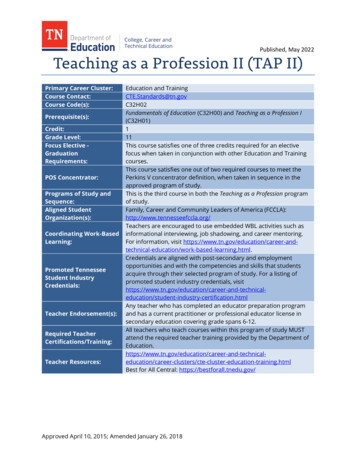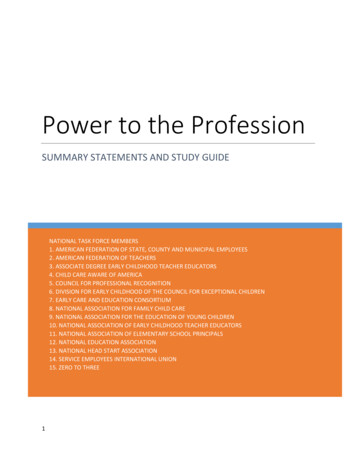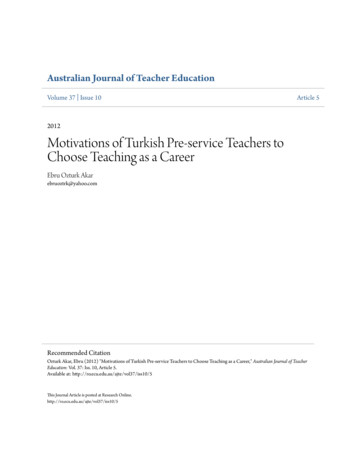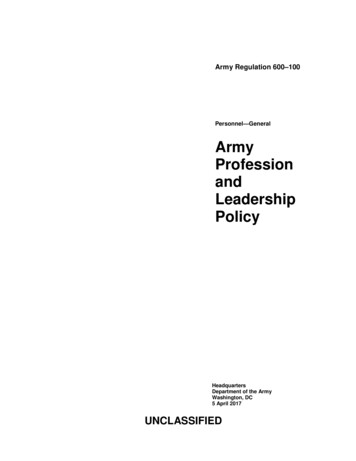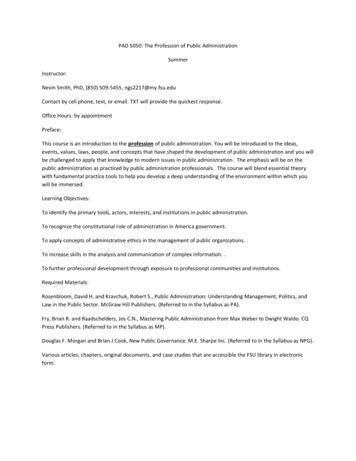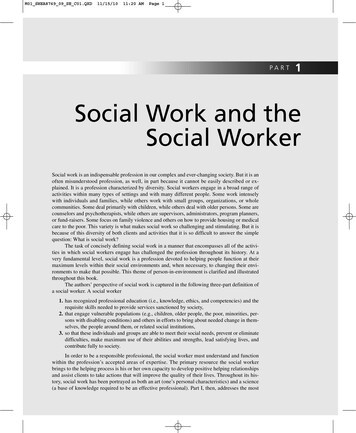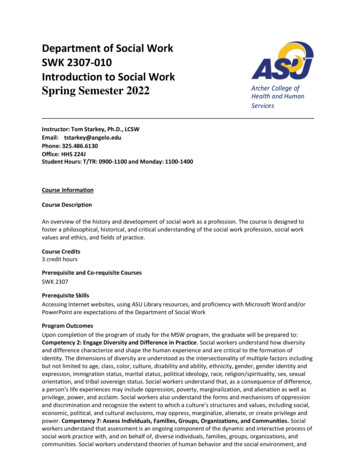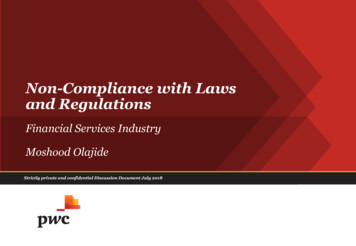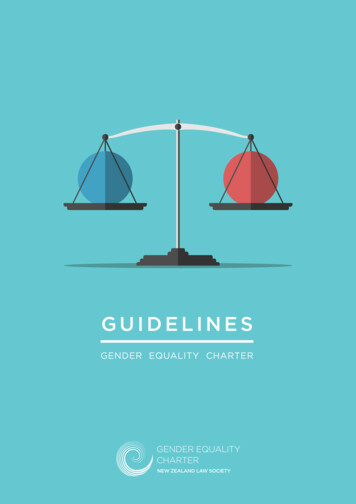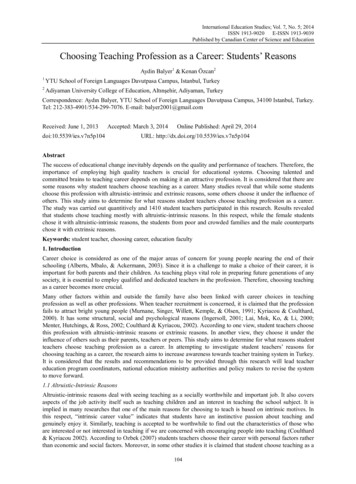
Transcription
International Education Studies; Vol. 7, No. 5; 2014ISSN 1913-9020E-ISSN 1913-9039Published by Canadian Center of Science and EducationChoosing Teaching Profession as a Career: Students’ ReasonsAydin Balyer1 & Kenan Özcan21YTU School of Foreign Languages Davutpasa Campus, Istanbul, Turkey2Adiyaman University College of Education, Altınşehir, Adiyaman, TurkeyCorrespondence: Aydın Balyer, YTU School of Foreign Languages Davutpasa Campus, 34100 Istanbul, Turkey.Tel: 212-383-4901/534-299-7076. E-mail: balyer2001@gmail.comReceived: June 1, 2013Accepted: March 3, 2014doi:10.5539/ies.v7n5p104Online Published: April 29, 2014URL: http://dx.doi.org/10.5539/ies.v7n5p104AbstractThe success of educational change inevitably depends on the quality and performance of teachers. Therefore, theimportance of employing high quality teachers is crucial for educational systems. Choosing talented andcommitted brains to teaching career depends on making it an attractive profession. It is considered that there aresome reasons why student teachers choose teaching as a career. Many studies reveal that while some studentschoose this profession with altruistic-intrinsic and extrinsic reasons, some others choose it under the influence ofothers. This study aims to determine for what reasons student teachers choose teaching profession as a career.The study was carried out quantitively and 1410 student teachers participated in this research. Results revealedthat students chose teaching mostly with altruistic-intrinsic reasons. In this respect, while the female studentschose it with altruistic-intrinsic reasons, the students from poor and crowded families and the male counterpartschose it with extrinsic reasons.Keywords: student teacher, choosing career, education faculty1. IntroductionCareer choice is considered as one of the major areas of concern for young people nearing the end of theirschooling (Alberts, Mbalo, & Ackermann, 2003). Since it is a challenge to make a choice of their career, it isimportant for both parents and their children. As teaching plays vital role in preparing future generations of anysociety, it is essential to employ qualified and dedicated teachers in the profession. Therefore, choosing teachingas a career becomes more crucial.Many other factors within and outside the family have also been linked with career choices in teachingprofession as well as other professions. When teacher recruitment is concerned, it is claimed that the professionfails to attract bright young people (Murnane, Singer, Willett, Kemple, & Olsen, 1991; Kyriacou & Coulthard,2000). It has some structural, social and psychological reasons (Ingersoll, 2001; Lai, Mok, Ko, & Li, 2000;Menter, Hutchings, & Ross, 2002; Coulthard & Kyriacou, 2002). According to one view, student teachers choosethis profession with altruistic-intrinsic reasons or extrinsic reasons. In another view, they choose it under theinfluence of others such as their parents, teachers or peers. This study aims to determine for what reasons studentteachers choose teaching profession as a career. In attempting to investigate student teachers’ reasons forchoosing teaching as a career, the research aims to increase awareness towards teacher training system in Turkey.It is considered that the results and recommendations to be provided through this research will lead teachereducation program coordinators, national education ministry authorities and policy makers to revise the systemto move forward.1.1 Altruistic-Intrinsic ReasonsAltruistic-intrinsic reasons deal with seeing teaching as a socially worthwhile and important job. It also coversaspects of the job activity itself such as teaching children and an interest in teaching the school subject. It isimplied in many researches that one of the main reasons for choosing to teach is based on intrinsic motives. Inthis respect, “intrinsic career value” indicates that students have an instinctive passion about teaching andgenuinely enjoy it. Similarly, teaching is accepted to be worthwhile to find out the characteristics of those whoare interested or not interested in teaching if we are concerned with encouraging people into teaching (Coulthard& Kyriacou 2002). According to Ozbek (2007) students teachers choose their career with personal factors ratherthan economic and social factors. Moreover, in some other studies it is claimed that student choose teaching as a104
www.ccsenet.org/iesInternational Education StudiesVol. 7, No. 5; 2014career since it is an autonomous profession while some others think that they can stay young in this profession.What is more, while some candidates think that they can bring up their children in this profession easier than anyother work, some others have some ideological approaches like influencing young generations (Kelly, 2012;Lawver & Torres, 2011). Hacıomeroglu and Taskın (2010) found that while some candidates choose the career asthey think that the profession is respectable and they like teaching children, others think that the profession willmake them happy. Tataroglu, Ozgen, and Alkan (1998) assert that they have an interest and love in teaching, seethe profession as an appropriate, respectable and blessed work.1.2 Extrinsic ReasonsIt is revealed in some studies that student teachers are motivated to join profession with mostly extrinsic reasons(Chan, 1998). Extrinsic reasons refer to economic as well as conditions of service and social status. It isconsidered that students are interested in teaching as a career, and generally regard teaching as a preferred andrespected occupation (Lai, Ko, & Li, 2000). Students who are interested in teaching consider teaching career forits enormous contribution to society, good salaries and good working conditions. The security of employmentoffered by teaching and the attractive working hours and longer holidays (Butcher & Lewis, 2002; Knobloch,2005; Stiegelbauer, 1992; Hayes, 2000).1.3 Influence of OthersMaking their career choice under the influence of others means choosing the profession as a result of their peers,teachers, relatives and parents’ effect (Murnane, Singer, Willett, Kemple, & Olsen, 1991; Bastick, 2000; Brown,1992; Chuene, Lubben, & Newson, 1999; Saban, 2003; Cermik, Dogan, & Sahin 2010; Behymer & Cockriel1988; Kniveton, 2004; Y. Boz & E. Boz, 2008; C. Papanastasiou & E. Papanastasiou, 1997, 1998; Hacıomeroglu& Sahin, 2009; Ubuz & Sarı, 2008). Student motives are also influenced by their own images and experiences ofschool life and the work of teachers (Hutchison & Johnson, 1994; Butcher & Lewis, 2002; Reid & Caudwell,1997; Chan, 1998; Heafford & Jennison, 1998).Taking everything into consideration, it is evident that teacher candidates choose their career with differentreasons. For this reason, this study aims to discover for what reasons student teachers choose teaching professionas a career. It also purposes to find out if variables like gender, department, grade, family social background,place they live, age produce significant difference.2. MethodologyThis study employed a survey method. The data were collected through a scale called the “Choosing TeachingProfession as a Career Scale (CTPCS)”.2.1 SamplingThe sampling was determined through purposive sampling method. The advantage of this method is that theresearcher can use prior knowledge to choose respondents (Bailey, 1994). In this respect, 1410 student teachersparticipated in this research. And reliability and validity work was carried out 220 students out of this sample.Participants were from the Departments of Education from seven public universities (Adıyaman-18.0%; MusAlpaslan-17.7%; Cumhuriyet-15.4%; Artvin Coruh-13.1%; Mersin-12.0%; Sakarya 13.0% and Inonu-10.9%).Of these participants, 58.6% were female and 40.0% male. As far as their grade was concerned, 35.5% werefreshmen, 22.3% sophomore, 19.5% junior and 22.7% seniors. Of them, 19.5% were from the departments ofPrimary School Teaching, 17.7% Science and Technology Teaching, 15.2% Psychological Counseling andGuidance, 12.8% Pre-School Teaching, 10.0% Social Sciences Teaching, 9.6% Turkish Teaching, 8.9%Religious Studies and Ethics Education, 4.2% Mathematics Teaching, 2.1%.2.2 Scale Adaptation ProcessIn this study, the “Choosing Teaching Profession as a Career Scale (CTPCS)” was used with a written permissionof Lai, Chan, Ko and So who developed it. It was a 5-point Likert scale ranging from “Strongly Disagree” to“Strongly Agree” with a midpoint of 3. It had 22 items below three sub-dimensions: the altruistic-intrinsicreasons sub-dimension (9 items), the extrinsic reasons sub-dimension (8 items) and the influenced by otherssub-dimension (5 items). Cronbach Alpha Coefficient was discovered as 0.79 in general. This three-factorstructure explained 45% of the total variance.In the adaptation process of the original scale, back-translation technique was used. This technique is thepreferred one although it can be time consuming and expensive. In this technique, a scale is translated into thetarget language by one translator and then translated back into the source language by another independenttranslator who is blinded to the original questionnaire. The two source-language versions are then compared105
www.ccsenet.org/iesInternational Education StudiesVol. 7, No. 5; 2014(Sperber, 2004; Looman & Farrag, 2009). Then, it was proofread by 48 students. As a result, it was proved thatthe language was understandable, the scale was valid and usable in the Turkish Culture.2.3 Confirmatory Factor Analysis (CFA)CFA is considered to be a general modeling approach that is designed to test hypotheses about a factor structurewhose number and interpretation are given in advance (Raykov & Marcoulides, 2000). In CFA, on the otherhand, one builds a model assumed to describe, explain, or account for the empirical data in terms of relativelyfew parameters (Jörreskog & Sörbom, 1993). The technique of CFA analyzes a priori measurement model inwhich both the number of factors and their correspondence with the indicators are explicitly specified (Kline,2011). The most frequent used statistics regarding CFA and model-data is Chi-square (χ2), RMSEA, NFI, NNFI,CFI, GFI, and AGFI. The goodness of fit index (GFI) of the items was presented in Table 1.Table 1. The goodness of fit indexesFit indexAcceptable fit indexSuggested model (n:220)χ2 /df0 χ2 /sd 3487.18/206 2.36RMSEA.05 RMSEA .10.08RMR.00 RMR .10.10SRMR.00 SMR .10.09NFI.90 NFI .95.95NNFI.95 NNFI .97.95CFI.90 CFI .95.92GFI.90 GFI .95.90AGFI.80 AGFI .90.80PGFI.00 PGFI .95.66As seen in the Table 1, Chi-square test is significant (χ2 487.18, df 206 and χ2/df 2.3 32, p .00). Whatis more, the goodness of fit index (GFI 0.90), the adjusted goodness of fit index (AGFI 0.80), the normed fitindex (NFI 0.95), the non-normed fit index (NNFI 0.95), the comparative fit index (CFI 0.92), the rootmean square residual (RMR 0.10) are indicating good fit. The root mean square error of approximation(RMSEA 0.08), as well as the standardized root mean square residual (SRMR 0.09) indicate good fit.Furthermore, the overall model fit statistics in LISREL is within the generally accepted thresholds and suggestsan acceptable goodness-of-fit. As a result of this analysis, it was discovered that results indicated good fit (Cote,Netemeyer, & Bentler 2001; Vieira, 2011; Hooper, Coughlan, & Mullen, 2008; Brown, 2006; Schreiber, Stage,King, Nora, & Barlow, 2006; Schermelleh-Engel, Moosbrugger, & Müller, 2003; MacCallum, Browne, &Sugawara, 1996; Hu & Bentler, 1999; Baumgartner & Homburg, 1996). Road scheme of student teachers’perceptions was shown in Figure 1.106
www.ccsennet.org/iesInternationnal Education StuudiesVol. 7, No. 5; 2014Figure 1. RoadRscheme off student teachhers’ perceptionn rates of threee-dimension mmodelsmongHere, corrrelations weree analyzed beelow three suub-dimensionss. According to this, the correlation amaltruistic-intrinsic and extrinsic sub--dimensions wwas 0.42. Thee correlation between altruuistic-intrinsic andinfluencedd by others is 0.12 and extrrinsic and influuenced by othhers is 0.42. TThis moderate correlation ammongsub-scales shows that eaach subscale eexists in the coonstruct itself (Peter 1981). In the altruistic-intrinsic reaasonssub-dimennsion, the lowwest error varriance was 0.38, and the highest was 0.64. In thee extrinsic reaasonssub-dimennsion, while thhe lowest significance valuee was 0.35, thee highest was 0.92. In the iinfluence by othersosub-dimennsion, the loweest significancce value was 0.44 and the hhighest was 00.76. These vaalues indicatedd thaterror variaances were in acceptablealimiits in this studyy.2.4 ReliabilityThe reliabbility coefficiennt of the adaptted scale was found as 0.91 for the altruisstic-intrinsic suub-dimension, 0.80for the exttrinsic reasonss sub-dimensioon and it was 0.74 for the innfluenced by oothers sub-dimmension. Generally,reliability coefficients vaalues around 00.80 are “very good,” and vaalues around 0.70 are “adequuate” and over 0.70as “excelleent” (Kline, 20011). Thereforee, it can be saidd that the reliaability coefficieent is excellennt for this studyy.2.5 Data AAnalysisIn order tto analyze thee data, SPSS and Lisrel 8.880 packet proograms were uused. For the students teacchers’demographhic variables likelsocio-econnomic backgroound (educatioon level of parents, place wwhere their fammilieslive, familyy income, nummber of brotherrs and sisters),, grade, age, deepartment andd gender variabbles percentagee (%)and frequeency (f) and CrosstabsCanalyysis were donee. For significaance statistics and dual compparisons, t-testt wascalculated and for multii-comparisons,, one–way ANNOVA was maade. Significannce level was aaccepted as p 0.05for both ttests. In all tests,t“Test off Homogeneitty of Variancees” prerequisiite was proviided (p 0.05). Forsignificancce of the findinngs among grooups, Tukey muulti comparisoon test was useed.3. FindinggsAs far as thhe student teacchers’ demograaphics was conncerned, whilee 52.7% of the participants’ ffathers had primaryschool degree, 31.4% had secondarry, 14.5% uniiversity, and 1.4% master’s degree. Whhen their motthers’education level was conncerned, 72.7% of them wwere primary sschool graduattes, 23.2% seecondary and 4.1%4university graduates. Fuurthermore, 200.6% of the sttudent teacherrs’ families livved in villagess, 28.9% townnship,107
www.ccsenet.org/iesInternational Education StudiesVol. 7, No. 5; 201434.0% cities and 16.5% in big cities. Concerning the number of brothers and sisters, 7.7% of them had one, 16.5%two, 22.6% three, 18.9% four and 35.0% five or more brothers and sisters. Regarding the monthly family income,while 29.7% of them had approximately 1000 Turkish Lira and less, 29.2% between 1001-1500 TL, 19.1%between 1501-2000 TL, 11.4% between 2001-2500 TL, 5.8% of them between 2501-3000 TL and 4.7% of themhad 3001 TL and over.While 23.1% of the student teachers stayed with their families or relatives, 40.7% at public dormitories, 16.5%private or foundation dormitories, and 19.6% with their friends. 76.0% of the participants took bursary or studentloans. Of the participants, while 38.4% studied in the same city, 26.0% in a neighboring city, 15.2% in the samegeographical area, and 20.4% in a different geographical area.When gender variable was concerned, significant differences were discovered among their views on careerchoice and altruistic-intrinsic reasons [t(1408) 2.09, p .05]. According to that the female student teachers choosetheir careers with altruistic-intrinsic reasons compared to their male counterpartsAs far as the number of brothers and sisters was concerned, significant differences were also discovered. As such,those who come from crowded families make their choices with extrinsic reasons [F(4-1404 5.16, p .01]. Thestudents with five or more brothers and sisters choose their careers with extrinsic reasons compared to those withthree or less brothers and sisters (p .05).There were also significant differences between students’ views and extrinsic reasons in terms of the place theylive [F(4-1405) 7.98, p .01]. According to that the student teachers who lived in private dormitories chose careerswith extrinsic reasons compared to their counterparts who lived with their families, relatives or friends.When the influence by others sub-dimension was concerned, significant differences were discovered [F(4-1405) 3.30, p .05]. According to that the student teachers who lived in private dormitories were influenced by otherscompared to those who did not (p .05).As far as department variable and altruistic-intrinsic reasons were concerned, significant differences wereobtained [F(8-1401) 10.18, p .01]. The students from the Turkish Teaching Department chose their careers withaltruistic-intrinsic reasons compared to those from the departments of Primary School Teaching, MathematicsTeaching, Pre-school Teaching and Religious Studies and Ethics Education (p .05).Regarding department variable and extrinsic reasons, significant differences were found [F(8-1401) 7.04, p .01].According to that the students from the Psychological Counseling and Guidance Department chose their careerswith extrinsic reasons compared to those form the departments of Pre-School Teaching, Primary SchoolTeaching, Turkish Teaching, Mathematics Teaching and Science and Technology Teaching (p .01).When department variable and influenced by others sub-dimension were concerned, significant differences werediscovered [F(8-1401) 4.54, p .01]. According to that the students from the Religious Studies and EthicsEducation Department were influenced by others compared to those from the Psychological Counseling andGuidance Department (p .01). By combining positive and negative poles, uncertainty was neglected. Finally,descriptive statistics were presented in Table 2.108
www.ccsenet.org/iesInternational Education StudiesVol. 7, No. 5; 2014ff%agree%stronglyAgree and(N 1410)and disagreeChoosing teaching profession as a career scaledisagreeStronglyItems rankTable 2. Descriptive statisticsXSdAltruistic–intrinsicA1Teaching is Meaningful42029,883559,23,411,35A2Enjoy Being With Children41429,377554,93,381,30A3Wish to Help Others31722,591865,13,591,25A4Challenging Nature of the Job46032,668648,73,201,28A5Enjoy Being With Teenagers40528,776854,53,361,26A6Like Working in the School Environment39327,977554,93,381,27A7Fitting My Personality36425,883158,93,491,29A8Wish to Teach the Subject(S) I Like37926,979156,13,411,28A9Have Opportunities For Continuing Education44031,269549,33,231,27ExtrinsicA10Higher Salary80056,837626,72,481,33A11Good Working Hours41529,479756,53,381,30A12More Holidays46733,272351,33,261,32A13Better Job Security50535,866547,13,121,34A14High Social Status63745,247433,72,811,26A15Good Career Prospects61743,747934,02,821,27A16Government’s High Regard For Education71250,541129,12,611,28A17Easier to Find Teaching Vacancy69349,146132,72,711,35Influenced by othersA18Influenced By Peers84159,633223,52,441,27A19Influenced By Family Members75153,244131,22,651,33A20Influenced By the Mass Media83959,532122,82,421,23A21Influenced By Teachers58441,459842,52,971,37A22Reflect My Religious Belief60242,762044,03,031,44As seen in the Table 2, 65.1% of the students chose their careers to help children, 59.2% thought that teachingwas meaningful and 58.9% considered that the profession fit their personalities. Moreover, 56.1% wished to helpothers, 54.9% enjoyed being with children and 54.9% enjoyed working. While 56.5% of them chose teachingcareer because of good working hours, 51.3% chose it for longer holidays and 47.1% for better job security.While 56.8% of them strongly disagreed or disagreed that they chose the career for higher salary, 50.5% chose itfor government’s high regard for education, 45.2% high social status, 49.1% finding teaching vacancy easier.Although approximately 60.0% of the students stated that they were not influenced by their teachers, relatives,peers, media and family members, 42.5% were influenced by others.4. Discussion and ConclusionThe main concern of this study was to determine the reasons why student teachers choose teaching profession asa career. It also aimed to find out if variables like gender, department, grade, family social background, place109
www.ccsenet.org/iesInternational Education StudiesVol. 7, No. 5; 2014they live, age produced significant difference. In this respect, a number of results were obtained.According to one of the results, most of the student teachers of this sample came from poor, lower educatedfamilies who mostly lived in villages or townships. They mostly stayed at public, foundation or privatedormitories and met their financial needs with bursaries or student loans. They also attend to universities mostlyin the city where they are currently living or a neighboring city and the places where geographically in the sameregion. As can be understood, the students who choose teaching as a career come from generally poor, middleclass and crowded families. This is probably because of the economic difficulties that the families have. They donot want to send their children to far and big cities to attend university as life standards are comparatively higherin big cities compared to cities they currently live. It is easier to meet their needs when children stay with them attheir homes. Several studies discovered similar results. These studies prove that teaching is a profession ofeconomically lower or middle classes (Banks, 1995; Ladson-Billings, 1999; Zeichner, 1996; Durcharme & Agne,1989; Villegas, 1993; Sleeter, 2001).There is also difference between “salary” and “working with children” factors in terms of gender. In other words,while women prefer working with children, males prefers for salary. The student teachers who had more brothersand sisters chose the profession with extrinsic reasons. In the Turkish Society, in crowded families, it wasexpected from a child to choose a career which provides job security. It seemed that economic reasonsdetermined career choice of children at crowded families. In this respect, it is known that finding work inteaching career is relatively easy although it becomes tough at times. In some studies, it is considered as aprofession that contributes to society, salary and status (Johnston, McKeown, & McEwen, 1999). Moreover, insome studies it is claimed that student teachers consider the profession as an important career choice (Kyriacou& Coulthard, 2000; Fwu & Wang, 2002). While some researches include opportunities (Borchert, 2002) andsome others imply teacher factor (Goh & Atputhasamy, 2001; Park, 2005; Cermik, Dogan, & Sahin, 2010; Kok,2012).Many studies reveal that gender related issues determine this choice as well. In this respect, according to anotherresult obtained from this research, the female student teachers chose teaching profession as a career withaltruistic–intrinsic reasons. It is indicated that they perform the profession with love and commitment. This isconsistent with the results which were found in some other studies (Butcher & Lewis, 2002; Chan, 1998;Daehlen, 2007; Hutchinson & Johnson, 1994; Johnston, McKeown, & McEwen, 1999; D. Newby, Smith, R.Newby, & Miller, 1995; Saban, 2003; Topkaya & Uztosun, 2012). The 2009-2010 school statistics also proves it.According to that, 95.0% of pre-school teachers were female, 52% primary education, 41.9% secondary schoolin Turkey (Fwu & Wang, 2002). This shows that teaching is perceived as a feminized profession (Creed & Patton,2003; Spitze & Logan, 1990; Wilgosh, 2002; Miller, Lietz, & Kotte, 2002; Heckert et al., 2002; Small &McClean, 2002; Bailyn, 2003; Basten, 1997).On the other hand, in some other researches it is claimed that male candidates choose the profession for its status,salary and career opportunities. In this regard, male students are more influenced by status, salary and careeropportunities. According to them, the factors influencing the choice of primary teaching as a career optionamong sixth formers differed significantly between males and females. Here, the female students tend to valueteaching as a profession more highly than their male counterparts (D. Newby, Smith, R. Newby, & Miller, 1995;Butcher & Lewis, 2002; Johnston, McKeown, & McEwen, 1999; Foster & Newman, 2005; Saban, 2003;Smedley, 2007; Parr, Gosse, & Allison, 2008; Ozbek, 2007; Sahin, Cokadar, & Usak, 2008). In some studies itwas discovered that female teachers choose this career with intrinsic reasons different from male ones (Saban,2003; Y. Boz & N. Boz, 2008; Hacıomeroglu & Sahin, 2009; Johnston, McKeown, & McEwen, 1999).In another study, it was discovered that while some candidates liked teaching others, some others chose itbecause they believed that the profession was respectable. They also liked longer holidays, employmentopportunities, working hours and conditions as well as job security (Hacıomeroglu & Taskın, 2010). In anotherstudy, it was discovered that while teachers chose the profession as it provided career opportunities andcontributions to the society (Lai, KO, & Li, 2000). Oruc (2011) discovered that trainee teachers have positiveperceptions about teaching career.In this research, it was also found that a great deal of student teachers consider teaching as a blessed profession.It may stem from the perception of teaching in the historical process. In the ancient civilizations and societieslike Sumerians, Egyptians, Israeli, and Indian and later in Muslim societies, teaching is considered as one of themost blessed professions (Sonmez, 2010). Moreover, Yuce, Sahin, Kocer, and Kana (2013) found out thatextrinsic, altruistic, and intrinsic motivations play important roles while choosing teaching career. Ozturk andAkar (2012) the social-cultural context of Turkish society shaped participants’ motivations and perceptions.110
www.ccsenet.org/iesInternational Education StudiesVol. 7, No. 5; 2014As far as department variable was concerned, while the students from the department of Turkish Teaching chosethe career with altruistic–intrinsic reasons, those from the Psychological Counseling and Guidance Departmentchose it with extrinsic reasons. The students from the departments of Religious Studies Department and EthicsEducation chose it under the influence of others.It is discovered by many student teachers have some reasons to choose teaching profession as a career. Thesereasons may be altruistic-intrinsic reasons, extrinsic reasons, self-realization reasons, material reasons, influenceby others reasons or some other ones. No matter what reasons they choose the profession for, it has a significanteffect in educational system as well as their own lives. Therefore, it can be concluded that pre-service educationshould be organized with respect to educational goals primarily. Students may have their own reasons, buteducational institutions have their priorities and aims that are more important than personal reasons. Therecommendations reached through the results obtained in this study are below: Most student teachers tend to attend to universities and also work in the same city, which may limittheir points of views. Therefore, they should benefit from Farabi and Erasmus programs to broaden theirpoints of views. Number of Anatolian Teacher Schools should be increased as well as their quality. As students whoattend these schools may probably choose the career with altruistic–intrinsic reasons, students should beinclined to colleges of education from these schools. Students should be supported in terms of food, housing, loans and bursary. An interview should be conducted to choose students for colleges of education instead of central exams. It is considered that the status of teaching career is relatively low. It is thought that it should beincreased to attract successful students to the profession.ReferencesAlberts, C., Mbalo, N. F., & Ackermann, C. J. (2003). Adolescents’ perceptions of the relevance of domains ofidentity formation: A South African cross-cultural study. Journal Youth and Adolescence, 32(3), ailey, K. D. (1994). Methods of Social Research (4th ed.). New York, N.Y.: A Division of Macmillan Inc.Bailyn, L. (2003). Academic careers and gender equity: Lessons learned from MIT. Gender Work andOrganization, 10(2), 137-153. http://dx.doi.org/10.1111/1468-0432.00008Banks, J. A. (1995). Multicultural education: Historical development, dimensions, and practice. In J. A. Banks, &C. A. M. Banks (Eds.), Handbook of Research on Multicultural Education. New York: Simon and SchusterMacmillan.Basten, C. (1997). A Feminised Profession: Women in the teaching profession. Educational Studies, 23(1), stick, T. (2000). Why teacher trainees choose the teaching profession? Comparing trainees in metropolitan 04090415953Baumgartner, H., & Homburg, C. (1996). Applications of structural equation modeling in marketing andconsumer research: A review. International Journal of Research in Marketing, 13(2), 38-0Behymer, J., & Cockriel, I. W. (1988). Career choice conflict. Journal Career Development, 15(2), 06Borchert, M., (2002). Career choice factors of high school students (Unpublished Master of Science thesis,University of Wisconsin-Stout).Boz, Y., & Boz, N. (2008). Kimya ve matematik ogretmen adaylarinin ogretmen olma nedenleri. KastamonuEgitim Dergisi, 16(1), 137-144 [In Turkish].Brown, M. M. (1992). Caribbean first-year teachers’ reasons for choosing teaching as a career. Journal ofEducation for Teaching, 18(2), 185-195. http://dx.doi.org/10.1080/0260747920180207Brown, T.
This study employed a survey method. The data were collected through a scale called the "Choosing Teaching Profession as a Career Scale (CTPCS)". 2.1 Sampling The sampling was determined through purposive sampling method. The advantage of this method is that the researcher can use prior knowledge to choose respondents (Bailey, 1994).

